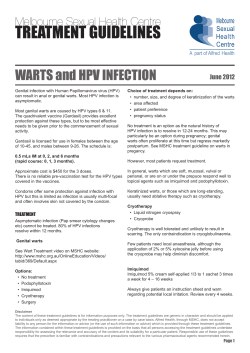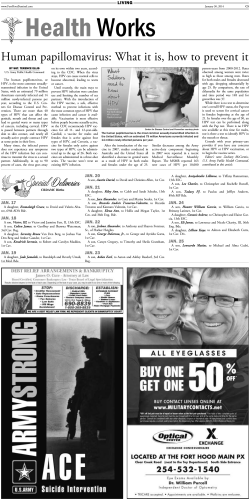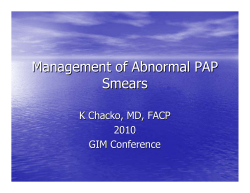
What should I know about HPV?
PATIENT PARTICULARS Human Papillomavirus and Men: Questions and Answers What should I know about HPV? Jessica Hilst, OMS III, and Tyler C. Cymet, DO if his or her male partner has HPV. The following commonly asked questions, with included answers, are designed to address such aspects of HPV infection. This fact sheet has been created for your patients by the American Osteopathic Association. Use the information that follows as a means of discussing HPV with your patients. The human papillomavirus (HPV), the HPV quadrivalent vaccine and cervical cancer have been much in the news since 2006, when the vaccine became available for prevention of HPV-caused cervical cancer. However, HPV does not affect only women. More than half of men who are sexually active will have HPV infection at some time during their lives.1,2 Most men have healthy immune systems that will clear HPV infection on their own. Many of these men will not even be aware that they have a viral infection. In some men, however, HPV infection progresses to much more serious conditions. At any one time, approximately 1% of the sexually active male population has genital warts, most of which are caused by HPV types 6 and 11.1,2 Other types of HPV, most commonly types 16 and 18, may cause cancers of the oral cavity, penis, and rectum. In several US based studies of heterosexual men, approximately one-third of those men were infected with cancerous strains of HPV. 3 According to the February 2008 Journal of Clinical Oncology,4 HPV infection will surpass alcohol and tobacco as the leading cause of oral cancer within the next 10 years. Anal cancer has increased threefold in the past 30 years, and most new cases are attributable to HPV infection.3 Although such manifestations of HPV infection remain relatively rare in men, it is important for a man or woman to know questions to ask his or her male partner in regard to HPV and to know actions to take Questions and answers 䡲 1) I think my partner has HPV infection. What should we do? Most people who have had multiple sexual partners will become infected with HPV. In many cases, HPV infection will resolve on its own within one- to two-years without causing serious complications. One study showed that 75% of men tested negative for HPV 12 months after initial detection.5 Most infected people do not even know that they have HPV. If your partner has any symptoms of a sexually transmitted disease (STD), such as genital warts, genital itching, penile discharge, or pain with urination, he should see his physician. Physicians can prescribe various medications to manage STDs. Valacyclovir hydrochloride is an oral medication that can help decrease outbreaks of HPV-associated genital warts as well as reduce your chances of spreading HPV.6 Once you or your partner has an outbreak, there are several topical medications that can be applied directly to genital warts to speed recovery, such as Imiquimod.7 䡲 2) What will lower my chances of getting HPV from my partner? The only sure way to prevent the spread of HPV is to abstain from oral, anal and vaginal sex. Wearing a condom reduces the risk of HPV transmission, but a condom does not cover all of the dermatologic areas from which HPV can be transmitted between partners. The human papillomavirus can be present on body areas other than the shaft of the penis, such as the thighs, testicles and base of the penis. In women, HPV can infect all areas of the vagina and thighs — that are also not protected with condom use. If your partner has HPV, your chances of contracting the virus are lessened if he does not have visible warts. However, you should keep in mind that you can still contract the virus during wart-free periods too. 䡲 3) I was vaccinated with the HPV vaccine. Does that mean I cannot get HPV infection? No. The quadrivalent vaccine approved by the US Food and Drug Administration (FDA) for protection against HPV, prevents infection of only HPV types 6, 11, 16, and 18. Although these four types of HPV are the most common cases of genital warts and cervical cancer, other less common HPV types can also cause disease. Thus, the HPV quadrivalent vaccine protects against most strains of HPV that cause genital warts and cancer, but you still remain susceptible to other strains. (continued on the next page) 15 䡲 4) What increases my risk of getting HPV infection? Studies have shown that having unprotected sex, frequent sex and multiple sex partners, as well as smoking and being an uncircumcised man, all enhance the chances of getting HPV infection.8,9 Having sex with a new partner puts you at greater risk than having sex with a previous partner.2 Having sex at a young age and having a partner who has had multiple sex partners also increase the risk of HPV infection, as well as of other STDs. 䡲 5) What test can my partner take to tell if he has genital warts? Genital warts are not always readily visible. A physician can apply an acetic acid-based solution (ie, vinegar) on a patient’s genital area to help identify warts. When this solution is applied, any warts that are present will turn white, making them easier to see. However, these tests can yield false-positive results. Thus, a skin biopsy may be called for in many cases. 䡲 6) What test can my partner take to tell if he has HPV-related cancer? There is currently no regularly used test that is available for determining if a man— whether heterosexual or homosexual—has HPV-related cancer. Some physicians recommend using anal Papanicolaou (Pap) smear tests with gay and bisexual male patients to check for the presence of cancerous cells.2 This recommendation, however, remains controversial, because removing cancerous or precancerous cells detected by Pap smear tests in men—unlike in women—has not been shown to decrease cancer rates. 䡲 7) If my partner has HPV-related cancer, what is the treatment? Patients with HPV-related penile, anal and oral cancers can be treated with chemotherapy, radiation, and surgery like other kinds of cancer. The treatment of cancer will be decided between you and your doctor and depends on the type of cancer and its level of development. 16 䡲 8) What does having HPV infection mean for my overall health and that of my partner? Most of the approximately 100 types of HPV do not cause any symptoms at all and resolve on their own. Some types of HPV cause warts to develop on the anus, genitals or thighs. These warts can be uncomfortable and itchy and bleed with contact. A woman who has HPV infection is at increased risk for cervical cancer. She should be regularly screened for precancerous and cancerous cells with an annual Pap smear test. In men and women, approximately 40 of the approximately 100 types of HPV are sexually transmitted and can lead to penile, rectal, cervical or oral cancer.2 The chances of getting cancer from HPV infection are much lower in men than in women. Men who are circumcised are at lowest risk for the development of penile cancer. In November 2008, the US Centers for Disease Control and Prevention (CDC) published a comprehensive assessment of HPV-related cancer, based on registry data from the CDC and National Cancer Institute that were collected between 1998 and 2003.10 According to the study,10 about 800 men each year get penile cancer associated with HPV, about 1,100 men and 1,900 women each year get anal cancer associated with HPV, and about 10,800 women per year get cervical cancer associated with HPV. Although HPV-related cancer is relatively rare in men, any man who has HPV infection should check for physical changes that may be associated with cancer. If your partner has any changes to the color, skin texture or shape of his penis, or any open sores or abnormal growths on his genitals, these changes should be reported to his physician. Rectal cancer commonly does not result in physical signs or symptoms. Rather, rectal cancer is associated with changes in bowel habits, pain with defecation, rectal itching and abnormal discharge. All of these changes should be reported to the physician. Among men, cancer associated with HPV is most common in gay and bisexual individuals and in men with compromised immune systems, such as in cases of human immunodeficiency virus/acquired immunodeficiency syndrome (HIV/AIDS). 䡲 9) If I get HPV from my partner, does that mean he is cheating on me? The human papillomavirus can lay dormant in an individual’s body for several months or years after oral, vaginal or anal sex with an infected partner. And, without producing any physical signs or symptoms, it might be passed to other sexual partners. Thus, getting HPV infection from your partner does not necessarily imply that he had recent sexual relations with another individual. When two sexually active partners become infected, it is difficult to determine which partner had HPV first. It should be kept in mind that most people with multiple sexual partners will have HPV at some point during their lives, and most of those people will be asymptomatic and unaware that they have HPV infection. 䡲 10) If one of us has HPV, does that mean that the other one will get infected? Very commonly, if one person in a relationship has HPV, the other person in the relationship will also contract the infection. The likelihood of viral transmission is increased because, as previously mentioned, the infection can be present without producing visible symptoms. By the time genital warts develop in one partner—if they ever do—the second partner may have already contracted the virus. Transmission of HPV does not always happen, however. Chances of transmission can be reduced by wearing condoms and by avoiding sexual contact when visible warts are present. Most people who have HPV infections have strains that do not cause genital warts or cancer, and such infections resolve on their own over time. 䡲 11) Should my son, like my daughter, get vaccinated against HPV infection? In the United States, the quadrivalent HPV vaccine is FDA-approved only for use in girls and women between the ages of 9 and 26. In the United Kingdom, by contrast, HPV vaccines are on the market for use in males between the ages of 9 and 15, as well as for use in females. A randomized, double-blinded, placebo-controlled trial of the vaccine involving 4,065 young men between the ages of 16 and 26—the Male Quadrivalent HPV Vaccine Efficacy Trial Study Group— was conducted.7,8 Results of phase III of this trial were reported in November 2008 group and 31 cases in the placebo group.11,12 In December 2008, a request was made to the FDA for permission to market a quadrivalent vaccine for males between the ages of 9 and 26.13 True or false? 䡲 If my partner has HPV infection, I will be able to tell just by looking. False. Many people are infected with types of HPV that do not cause warts or any other physical signs or symptoms. In such cases, you would not be able to tell just by looking if that person has HPV infection. Your partner may not even know that he has HPV if he has no signs or symptoms. Physical signs of HPV infection, can include painless flat, raised, or cauliflowerlike growths on the penis, scrotum, rectum, anus or oral cavity. 䡲 There are more than 100 types of HPV. True. Of the more than 100 types of HPV, many do not cause any signs, symptoms or complications. Human papillmavirus types 6 and 11 cause 90% of all genital warts. Thirty other strains of HPV have been associated with penile, anal and oral cancers.1,2 䡲 The human papillomavirus cannot be transmitted if genital warts are not visible. False. If your partner has genital warts but is between outbreaks, you can still contract HPV infection from him. Similarly, if he has a type of HPV that does not cause warts, you can contract that infection. The only certain way to ensure that you do not get HPV from your partner is to abstain from oral, vaginal and anal sex. at the International Multidisciplinary Conference of the European Research Organisation on Genital Infection and Neoplasia (EUROGIN) in Nice, France. The completed primary analysis showed that the vaccine reduced external genital lesions caused by HPV by 90.4% (95% confidence interval, 69.2%-98.1%) in study participants aged 16 to 26—with three cases of genital warts in the vaccine 䡲 Gay and bisexual men are more likely to get HPV infection than other men. True. Men who have anal sex with other men are most likely to contract HPV infection. Of those men, gay or bisexual individuals with impaired immune systems, such as individuals with HIV/AIDS, are at the greatest risk for HPV infection. (continued on the next page) 17 10. CDC released first estimate of human papillomavirus-associated cancer data [press release]. City: Centers for Disease Control and Prevention; November 3, 2008. Available at: http://www.cdc. gov/media/pressrel/2008/r081103.htm?s_cid=mediar el_r081103_x. Accessed March 22, 2009. 11. Giuliano A, Palefsky J, on behalf of the Male Quadrivalent HPV Vaccine Efficacy Trial Study Group. The efficacy of the quadrivalent HPV (types 6/11/16/18) vaccine in reducing the incidence of HPV infection and HPV-related genital disease in young men. Paper presented at: International Multidisciplinary Conference of European Research Organisation on Genital Infection and Neoplasia; November 2008; Nice, France. 䡲 There is a cure for HPV infection. False. There is no cure for HPV infection in either men or women. If your partner has genital warts, the lesions can be frozen off or removed in a minor surgical procedure in the physician’s office. Most HPV infections resolve on their own. Until then, the infected individual should try to live a healthy lifestyle and get any warts examined by a physician. The partner of the infected individual should avoid contact with the warts. 䡲 Contact with warts on the fingers can cause genital HPV warts and vice versa. False. The human papillomavirus can cause warts on the fingers and feet, but these warts are caused by strains of HPV that are different from the strains that cause genital warts. Thus, if your partner has genital warts, they should not spread to your fingers or feet. However, warts that occur in the mouth, anus and genital areas may all be caused by the same strains of HPV. Thus, the best way to avoid spreading HPV is to avoid contact with any visible warts. ❙ ww 3. Epidemiology of Human papillomavirus infections. UptoDate Online version 17.1. Available at: http://www.utdol.com/content/search. Accessed March 25, 2009. ed and -unrelated oral squamous cell carcinomas in the United States. J Clin Oncol. 2008;26:612-619. hp. Accessed March 22, 2009. prevalence, incidence, and duration of human papillomavirus Infections in a Cohort of 290 US Men. J Infect Dis. 2008; Sep 15;198(6):827-35. 6. Valtrex and Genital Warts. Available at: http://www.valtrex.com/forherpes/increase_outbreak free.html. Accessed April 20, 2009. 7. External genital warts. Available at: http://aldara.com/aldara.jsp. Accessed April 20, 2009. 8. Lu B, Wu Y, Nielson CM, Flores R, Abrahamsen M, Papenfuss M, et al. Factors associated with acquisition and clearance of human papillomavirus infection 9. Nyitray A, Nielson CM, Harris RB, Flores R, Abrahamsen M, Dunne EF, et al. Prevalence of and risk fac- Cancer Biol. 1999;9:379-386. sexual men. J Infect Dis. 2008;197:1676-1684. 18 boys, young men; January 7, 2009. Medical News Today [serial online]. Available at: MR; Lee JH; Abrahamsen M; Harris RB. Age-specific tors for anal human papillomavirus infection in hetero- stdfact-hpv-and-men.htm. Accessed March 22, 2009. 13. Merck seeks FDA approval for HPV vaccine use in http://www.medicalnewstoday.com/articles/134590.p life cycle: active and latent phases [review]. Semin Web site. Available at: http://www.cdc.gov/std/hpv/ March 22, 2009. 5. Giuliano AR; Lu B; Nielson CM; Flores R; Papenfuss References fact sheet. Centers for Disease Control and Prevention [serial online]. Available at: http://www.medical ML. Incidence trends for human papillomavirus-relat- in a cohort of US men: a prospective study. J Infect 2. Sexually transmitted diseases: HPV and men––CDC in men; November 17, 2008. Medical News Today newstoday.com/articles/129676.php. Accessed 4. Chaturvedi AK, Engels EA, Anderson WF, Gillison Dis. 2009;199:362-371. 1. Stubenrauch F, Laimins LA. Human papillomavirus 12. Four-type HPV vaccine Gardasil¤ is also effective Jessica Hilst is a third year medical student at Nova Southeastern University College of Osteopathic Medicine. She is currently the president of the Student Government Association at NSUCOM as well as national 2nd vice chair of the Council of Osteopathic Student Government Presidents. She was recently selected as an Osteopathic Health Policy Intern for 20092010 by the American Association of Colleges of Osteopathic Medicine. Tyler C. Cymet, DO, is the associate vice president for medical education at the American Association of Colleges of Osteopathic Medicine. He is the president of the Maryland Association of Osteopathic Physicians and is on the Board of Trustees for DOCARE International. He can be reached at tcymet@aacom.org.
© Copyright 2025















